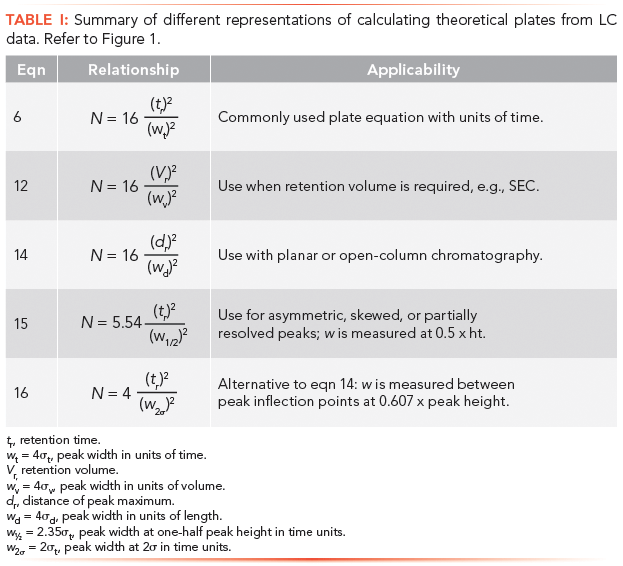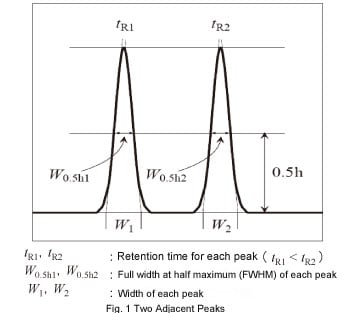Here the smaller the plate height the better the column. As per the United States Pharmacopoeia USP following formula is used to calculate the theoretical plates of.

Chromatography Fundamentals Part V Theoretical Plates Significance Properties And Uses
Selectivity Separation Factor Use Capacity Factors.

. As shown in Fig. The Length of the Column is the height of the chromatographic column in which the separation of particles. The theoretical plate number can also be represented in terms of peak area A and peak height H as shown in equation 4.
In gas chromatography capillary columns provide better resolution than packed columns because. Thus H has units of. HETP σ 2 L in which σ is the standard deviation and L the distance traveled.
By using experimental data of 1-alcohols and n-alkanes 2-ketones and 1-alkenes measured on capillary columns coated. Thus the defining equation of the height equivalent to a theoretical plate is as follows. The shorter each theoretical plate the more plates are contained in any length of column.
1 assuming a Gaussian distribution the peak width W is 4 σ and peak FWHM W05h is 2354 σ. The Plate height given standard deviation and length of column formula is defined as the ratio of the square of the standard deviation constant to the length of the column in which separation of particle takes place and is represented as H σ2 L or Plate Height Standard Deviation2 Length of the Column. This peak width W is based on the baseline intercepts of tangent lines to a Gaussian peak which is equivalent to the peak width at 134 of the peak height.
Void Volume from Column Dimensions Bookmark this page Ctrl-D for easy access. Equation 8-2 N 16 t R w b 2. Then n 554t_rw_122.
The number of theoretical plates is related to the retention time t_r and the width of the peak containing the compound. Substituting these values into equation 1 gives equations 2 and 3. The effective plate height heff is considered to be a better measure of the efficiency of capillary column than the conventional plate height h in isothermal conditions.
The Number of theoretical plates given length and height of column formula is defined as the ratio of the length of the column to the height equivalent to a theoretical plate and is represented as N L H or Number of Theoretical Plates Length of the Column Plate Height. If the peaks are reasonably symmetric it can be assumed that they have a Gaussian shape. H column heightN.
Hence the resolution of peaks also depends upon the column efficiency ie. N the number of theoretical plates is one index used to determine the performance and effectiveness of columns and is calculated using equation 1. The theoretical plate height is given by.
High column efficiency is needed to resolve the narrow peaks in the drug analysis. Gas Chromatography 5 The major contribution to the band broadening in gas chromatography is _____ 5 6 Choose the true statements. A calculation method for the prediction of effective plate height in capillary gas chromatography.
The use of the plate height is superior to the use of peak width in evaluating various chromatographic systems because it is constant for the chromatographic run and it is nearly constant from solute to solute. They have decreased plate heights. H L N displaystyle H frac L N where L is the column length and N the number of theoretical plates.
Calculate the number of theoretical plates N and the plate height H when the retention time is 2040 minutes half of the base width given in minutes is 065 minutes and the column length is 30 cm. The theoretical plate number N usually is expressed by one of two equations 9. They dont have band broadening due to the multipath process.
H reduced plate height sometimes referred to as the number of band widths H height equivalent of a theoretical plate µm d p mean particle size µm. Pressure Due to ID of Tubing. Practical application of N N is usually used to measure and verify the performance of a column.
A measure of the efficiency of a chromatography column is the height equivalent to a theoretical plate or plate height H70 The plate height for an experimental chromatogram is calculated from the expression. Where t R refers to the retention time of the peak and W b refers to the peak width at baseline in Equation 8-2 and W h its width at half-height in Equation 8-3. The best measure of column efficiency is plate height H.
It is calculated using Equation 5 and usually reported in millimeters. Selectivity Separation Factor Use Retention Times. Here we only provide the formula for h.
Theoretical plates are calculated per meter length of the column and often called as Nm. Height Equivalent to a Theoretical Plate H Another measure of column efficiency is the height equivalent to a theoretical plate denoted as H. Shape to the chromatography peaks reflects the concentration profile of the analyte band.
Chromatography Theoretical Plate Column chromatography CalculationThis video explains about Chromatography Efficiency Calculation Simple Method Theoret. According to the theory a well packed column should have a reduced plate height h in the range of 2-3 at a reduced velocity v of about 3. 14 where L is the column length and N is the plate number.
When I preview the report I get a lot of good information about the instrument run conditions and the sample chromatogram but no performance values for the chromatogram such as plate height. The Standard Deviation is a measure of how spread out. Empty Column Volume from Dimensions Height Equivalent to a Theoretical Plate plate height Linear Velocity.
On that menu I chose Extended Performance for the Report Style. The peak resolution can also be related to N and with some algebra we get this equation. In the Data Analysis view under the report pull-down menu I chose Specify Report.
So its often useful to calculate the height of a theoretical plate H by dividing the length of the column by the number of plates. Equation 8-3 N 5 545 t R w h 2. Plates N can be determined by the following modified formula 554 W 1 2 t N R For a fixed length column the height equivalent to a theoretical plate H can be determined from the equation.
1231 Plate Height and Plate Number. Plate height is defined as where σ is the standard deviation in units of length along the column of the analyte concentration profile in its band and L is the length of the column. The relation between plate number and peak width at the base is given by.

Chromatography Fundamentals Part V Theoretical Plates Significance Properties And Uses

1 Calculate The Average Plate Height In Micrometers For This Separation Given That It Was Performed On A 25 4 Cm Long Column 2 Calculate The Resolution R For This Separation Using The Widths O

About Resolution Part 1 Shimadzu Shimadzu Corporation

Chromatography Efficiency Calculation Simple Method Theoretical Plates Plate Height Calculation Youtube
0 Comments